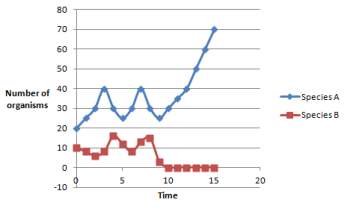1. species a and b are found in the same ecosystem. what could be inferred from the data shown
...

Biology, 13.12.2019 02:31 thhfvbjurddee
1. species a and b are found in the same ecosystem. what could be inferred from the data shown
in the graph below?
(1 point)
species a is a keystone species.
species b is the predator of species a.
species b is the prey of species a.
species a is a parasite of species b.
2. which of the following would be a reason for a species to undergo cyclic population changes? (1 point)
the keystone species in its ecosystem is removed.
the vegetation it eats increases and then decreases repeatedly with changing seasons.
its predator is preyed upon by a new species introduced to the ecosystem.
climate change alters the prevalence of parasites that affect the species.
3. panthers and pumas prey on a type of deer in a region. the deer feed on vegetation in the
region. what outcome could occur if the panthers and pumas are killed by humans?
(1 point)
the deer population will decrease, allowing the vegetation to become overgrown.
the deer population will increase, and will strip the region of the vegetation.
the deer population will be stabilized by the local vegetation.
the deer population will cycle between high and low numbers until a new predator moves in
which of the following is expected to occur if a keystone species is removed from an
ecosystem?
a niche is eliminated.
competition is reduced.
other species move toward more stable populations.
the ecosystem collapses.


Answers: 2


Another question on Biology

Biology, 22.06.2019 04:00
Cassandra made a venn diagram to compare and contrast the two stages of cellular respiration. which belongs in the area marked x? energy is released. oxygen is used up. glucose is broken down. carbon dioxide is used up.
Answers: 1

Biology, 22.06.2019 06:50
The kidney filters potentially toxic substances in the blood, and thus “clears” the blood of those substances. this clearance function is dependent upon and proportional to the diffusion gradient of the substance across filtering capillaries, i.e. if the concentration of the substance is doubled, twice as much will be cleared from each ml of blood that is filtered. suppose that the body produces a constant amount of a substance x per unit of time. the kidneys eliminate substance x at a rate directly proportional to the concentration of the substance and the volume of blood cleared each minute (c): elimination = c × [x], where [x] is the steady-state concentration of substance x. imagine an individual with an initial concentration of x equal to [x]0 who develops kidney disease. her baseline clearance c0 drops to one half of the original (½c0). what is the new steady state concentration of x? (for simplicity, assume that substance x is 100% filtered by the kidney).
Answers: 1

Biology, 22.06.2019 07:00
What terms describes being out of water after being submerged
Answers: 1

Biology, 22.06.2019 08:30
What are some natural processes that represent physical and chemical changes?
Answers: 1
You know the right answer?
Questions







Mathematics, 03.11.2020 03:20


Computers and Technology, 03.11.2020 03:20


Mathematics, 03.11.2020 03:20


Mathematics, 03.11.2020 03:20


Mathematics, 03.11.2020 03:20


Chemistry, 03.11.2020 03:20

History, 03.11.2020 03:20

Computers and Technology, 03.11.2020 03:20



